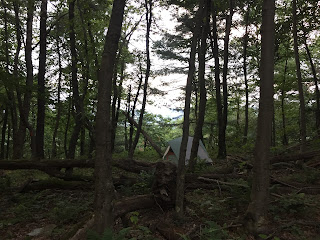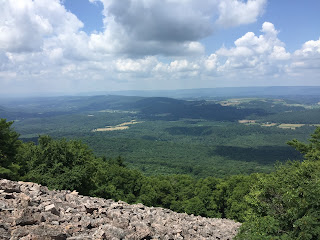This is Tionesta Creek, where it's joined by the much smaller Lamentation Run. There's probably no one left out there who remembers my first visit to this far-flung and pathless spot on the Allegheny National Forest, but that's okay. My older blog, where I described that visit, is finally falling into almost total disuse. I keep it online because it's the only documentation I have of my years living up there in the forest. But last week, I finally returned to commune again with the waters of Lamentation, where I have not been in nine years.
I don't see any changes, which is comforting. The last time I was here, I snapped pictures of exactly these two scenes: (top) the wooded hillside above Tionesta Creek--the hill where "Stony Point" is located--and (second from the top) the mythical Lamentation Run merging into the larger creek beneath the sheltering boughs of a hemlock. This time at last I came prepared to spend the night alone, to drift off to sleep with the watery music of Lamentation singing in my ears.
Despite the mournful moniker, the stream actually makes a happy enough sound--a rapid gurgling, something more akin to laughter than weeping. Despite the fact that there's no trail out to this spot, there's a large campsite with a stone fire ring down beside the smaller brook. I think horseback riders come out this way. Fishers in kayaks or canoes might also camp out there. But I found that camping spot a little too low-lying and exposed. Plus, I got the impression that someone felt a sense of ownership of that spot. They'd left cooking grills, a fire hook, and a few other camp items that made me think they could come back at any moment, and I didn't want to be there when they did. I opted instead for a little patch of forest at the top of the bluff to the left of the brook, a place where the darkness of the trees could take me in as night drew on, a place where I could shelter and look down to observe the established campsite if someone did show up to camp there.
This little fellow was my only companion--one of the little red salamanders that you see so frequently around here, about the size of my thumb. Some people call them hellbenders, though I cannot guess as to the origins of such a name. I also can't seem to get this picture right-side-up.
Lamentation Run Road is better known as Forest Road 210. The little lane does not pass right along the banks of the stream that gives it its name. It follows the course of the brook from a distance, built as it is at the top of the little valley--which is perhaps a quarter to a half-mile from the water. This means that you have to park your car somewhere along the road and bushwhack in. But the forest here is lovely and isolated, almost entirely made up of hemlocks with a polite smattering of beeches.
The problem with camping up atop the bluff is that there are no stones up there to build a fire ring--despite the many stones along the stream, below. I tried using moldering old "punky" logs to contain my campfire, but it proved a risky choice. If I come back to this spot, I'll have to put myself to the herculean task of hauling stones up from below--which will be hard without a path. But I do hope to come back here.
Disappointingly, I did not hear any owls in the night...and precious few wood thrushes. A large buck came rummaging around, snorting at me angrily in the dark. I made a loud, scary noise (one that I used to make to entertain my kids), and it eventually ran away. It was a perfectly serene spot for a woodland idyll. I'm becoming quite the expert on solo backpacking trips. I've been on my own for at least my last three outings, since my usual partners have been too busy. It's a whole different experience when you're alone, in some ways better and in some ways not.
Lamentation Run was named for the wolves that used to moan and cry along its banks. Lover of words that I am, the stream's name drew me to this little-visited quadrant of the Allegheny National Forest shortly before moving away to Pittsburgh, nine years ago. I didn't want to leave, and I came here to make lament. I wanted to see this body of water weeping the tears that I could not. I don't know why I couldn't cry; my sadness was very real. It still is. But I couldn't. It's just not my way. Coming here, all those years ago, was a pilgrimage for me. This most recent trip to Lamentation Run was a pilgrimage, too. I left with two liters of water from the holy brook. I've completely fetishized the very water of Lamentation. It was cold, and clear, and tasted sweet. I thought, "I'll take this back to the crowded, soulless places where I live now. I'll drink from it when I'm sad. It'll give me strength, and courage, and...I don't know. Peace?" How superstitious is that? Well, it doesn't matter anyway. I've already drunk it all.

























